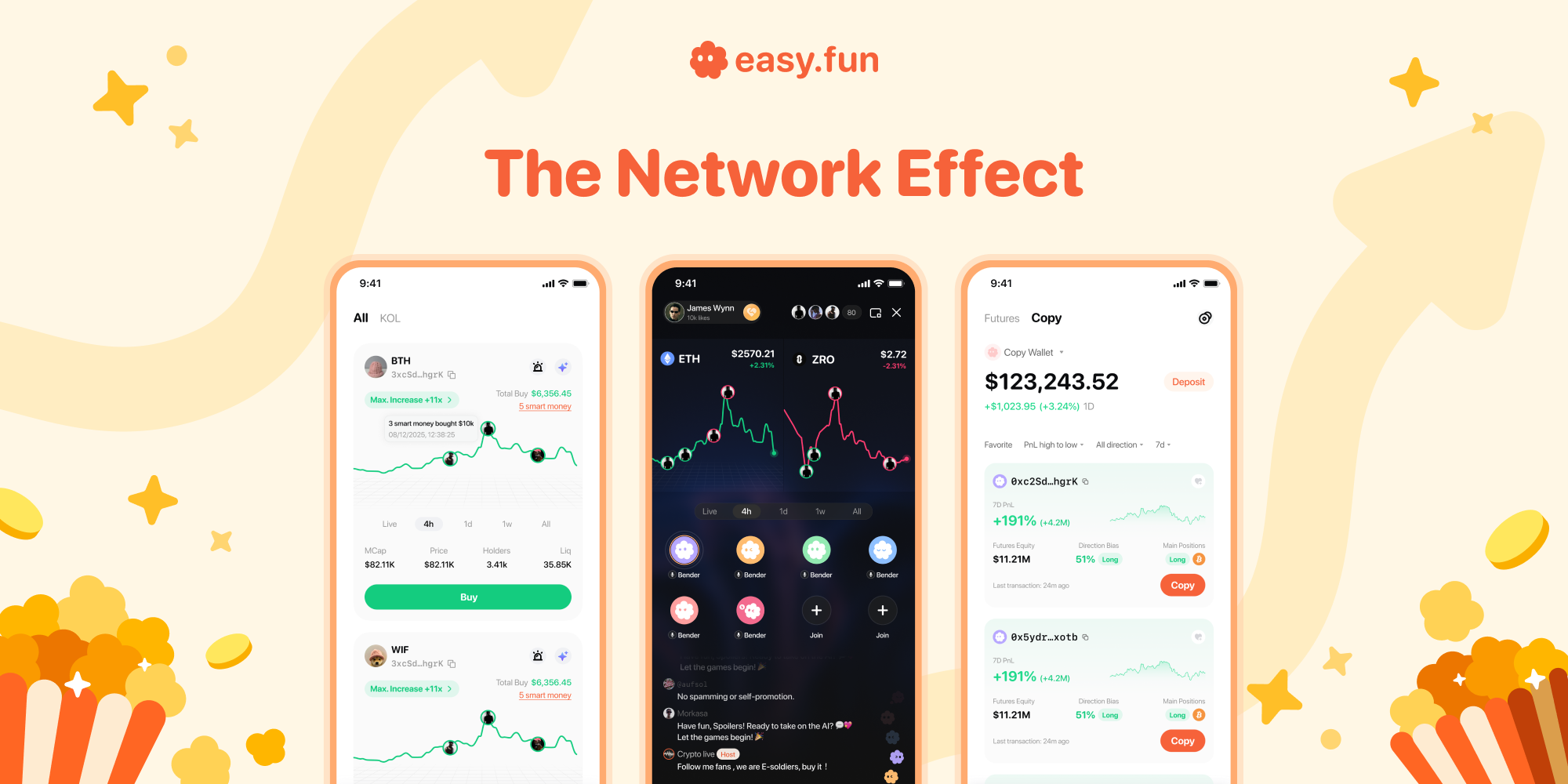3:17 AM. A trader sits alone, bathed in the cold glow of a multi-screen monitor. One chart paints a story of brutal, relentless day of selling. A dozen other tabs flash—Telegram, Twitter, Discord—a cacophony of red and green noise.
He’s hunting for a signal, for a reason, for anything. Is that alpha call real, or is he being baited into someone else’s exit liquidity? Is the group chat silent because they're still diamond-handing, or are they quietly selling off?
This day comes for each and every one of the millions of on-chain traders. It’s the central paradox of the degen economy: community drives value, but in the moment that matters, we stand alone.
It's mentally punishing, emotionally draining, and fundamentally inefficient. It's like shouting into a thunderstorm, trying to find a signal echoed back through the noise. But let’s be honest, the storm is the thrill—as exhilarating as it is terrifying: fortune and financial ruin. For many, it's not a flaw in the market, but a feature. While the rest of us stay inside, waiting for the sky to clear.
The market lacks the infrastructure to build a shared shelter, to create the social liquidity of a free and trusted flow of information that lets us ride out the storm together, as a community.
This is the problem we are here to solve.
The Social Fabric of a Degen Economy
To engineer a solution, you first have to deconstruct the existing structure. Without proper tools, on-chain communities have jerry-rigged their own protocols for sharing alpha. From a builder's perspective, these old structures are fundamentally flawed, opaque, brittle, and ready to fall.
Let’s look at the three little piggies of primary protocols governing today’s on-chain social trading:
The Telegram Signal Group: A Megaphone with No Verification
A Telegram group is a virtual rally. A "leader" broadcasts a signal to followers. The model's appeal is its simplicity. This house is made of straw.
Information Asymmetry: A critical lag exists between the broadcast and execution. In the front row, the inner circle cheers first, while the followers in the back of the room wait to trade on stale information. This isn't a bug; it's the implicit business model.
No Verification: The protocol has no native function to prove the signaler is acting on their own call. Wallets are unknown, positions unconfirmed. Followers stand on pure, exploitable trust, making them perfect exit liquidity.
Signal Degradation: As the group scales, signal-to-noise collapses. Every new member adds FUD, questions, and noise. The straw breaks, and the original alpha blows away.
The Private "Group Call": High-Trust & Closed Gates
To escape the noise, sophisticated traders retreat to private "war rooms." A small network of high-trust wooden fortresses, whose gates are closed.
Unscalable by Design: Its value is derived from exclusivity. This creates a bottleneck, preventing valuable insights from reaching a wider audience and blocking new talent from contributing.
Echo Chamber: High trust is a double-edged sword. Shared conviction quickly morphs into collective groupthink. Dissent is silenced, the opinions go unchallenged, bad ideas spread like a disease, and the group incurs catastrophic losses together.
Opaque Governance: Entry is based on social connections, not PnL. The network’s health is arbitrary, subject to social politics rather than verifiable merit. The wooden walls keep you in as much as they keep others out.
"Smart Money" Wallet Tracking: A Lagging, Context-Free Indicator
The most on-chain native protocol is tracking wallets with tools like Arkham. The logic: copy a winning trader. This is an attempt at verification, but it’s crude and misleading.
Lagging, Not Leading: You are always viewing the past. By the time a transaction is flagged, the alpha has left the room. You’re chasing their execution, not anticipating it.
Context-Free Data: You get the what, never the why. What’s their thesis? Their time horizon? Are they selling in five minutes or holding for five months? The storm is coming, but you don't when or where.
Manipulation: Sophisticated players know they’re being watched. They accumulate across dozens of wallets, then use their main, public-facing wallet for a single buy to pump their own bags. This is a house of cards.
These makeshift houses—of straw, wood, and cards—are proof of the community's drive to build, to collaborate, but they are damning evidence of the poor tools we've all been given. Billions have been lost, with countless hours wasted on rumor-chasing disguised as research. Let's build it right this time.
The Psychology of the Trench: The Cost of Isolation
The failures of these social protocols, these houses, are separated from the trading platforms. Both CEX and DEX treat trading as a lonely, monotenous task. They provide data—charts, order books—but zero social or emotional context.
We call this the Trench Mentality: forced to dig a trench, and focus only on the desperate, lonely act of survival. Just one emotional decision from zero-ing out.
The market dumps 40%. You open your exchange app. You see a chart flash red over a sea of sell orders. Every piece of data your tool provides screams that you are losing and caught out in the storm. What you don’t see is the conviction of other holders there with you. You have no visibility into the sentiment, resolve, or shared pain of your peers.
Are they holding, buying the dip, or retreating to fight another day. This uncertainty creates a prisoner's dilemma. The smart choice appears to be to sell before everyone else, even if everyone is better off holding. Panic selling is not a personal failing; it is the inevitable outcome of a system designed for isolation. A system designed for you to be left out, and left behind, holding just the order book they gave you.
This is where we take a principled stand. A trading platform in a community-driven market has a responsibility to do more than execute orders. It has a duty to make the experience of trading human again, like the old pits of New York exchanges. To ignore the social layer is to build yet another fundamentally broken shelter, exposed with no armor, map, or compass. You are leaving them in the trench, where they are destined to fail.
The Precedent: An Incomplete House
The market has proven the demand for a solution. The explosive growth of Clubhouse and Twitter Spaces was not a coincidence. It was a massive, untapped demand for real-time, voice-driven social expression. These platforms successfully engineered what we can call a "Layer 0" social protocol—the core infrastructure for voice aggregation at scale.
But for financial markets, their architecture is critically incomplete. Their fundamental failure is the absence of a native execution bridge—a single location where a trader can seamlessly receive a social signal and immediately trade on it.
A host on a Twitter Space can declare, "I'm aping this now!" The audience hears the conviction, but a chaotic scramble follows. Listeners switch apps, paste a contract address (praying it’s the right one), and execute on a separate platform.
In that perilous gap, there is no shelter. The link between social signal and trading order is severed, and trust erodes. Did the host really buy? Did they buy before the call? Is this the right contract? This disconnect is where confidence breaks, front-running happens, and opportunity disappears. The social layer and the execution layer exist in different houses, with nothing but risk between them.
The next step for market infrastructure is an obvious and necessary fusion: a real-time social layer integrated with a high-performance, on-chain execution. AKA, build one great big longhouse where everyone can trade and chat together.
One Longhouse for Everyone: easy.fun
This is what we built. easy.fun is not another DEX with a chatbox tacked on. It is a purpose-built social trading protocol, engineered from the foundation-up to weather the storm, and take shelter together. We aren't building a better Uniswap UI. We are building the missing infrastructure for social liquidity.
Our architecture transforms the isolated trench into a collaborative longhouse, founded on three pillars.

The Core Architecture: Three Pillars of the Ecosystem
The Platform (The Exchange): The foundation. A robust, fully decentralized, high-performance execution engine. On-chain complexity—gas, wallets, transaction speeds—becomes invisible. It is a seamless and secure base layer for social activity. Binance-level features, self-custody sovereignty. This is our Heart of Freedom.
The Host (The Signal Node): The creator, the alpha generator, the community leader. We give them a complete broadcast and monetization toolkit. With voice rooms, live trade feeds, and one-click copy trading, their influence becomes tangible economic value. This is our smart little piggy safe inside the house. Their PnL is their resume.
The Trader (The Participant): The user who can finally hear, verify, and act with clarity on signals. No longer a follower chasing stale alpha, but an active participant in a winning team, led by a Host they trust. They listen live, see the trades execute, and with one click, copy the trade. Safe and sound together.
The Network Effect: The Influence Economy
These pillars create a powerful feedback loop. It's a meritocracy where the best traders rise based on transparent, on-chain performance, and followers benefit directly from their expertise.
Better Platform Tools → Attracts talented Hosts → Hosts share high-quality, verifiable alpha → Traders join, profit, and build trust → Trader activity (volume, tips, fees) rewards Hosts and generates revenue → Platform reinvests revenue into Better Tools.
This is the Trader-as-Creator economy, where influence is a verifiable and monetizable asset.
The "How": Engineered Features, Not Gimmicks
This architecture is brought to life through features engineered as direct solutions.
Voice Rooms + Live Trade Feeds: We built the Clubhouse model on a foundation of on-chain activity. A Host can talk strategy while every participant sees their buys and sells appear live. Talk is cheap, but on-chain actions are forever. This is the ultimate verification layer.
One-Click Copy Trading: The execution bridge that Twitter Spaces is missing. It closes the perilous gap between signals and trading. When a Host you trust moves, you move. It democratizes access to expert-level execution.
Gamified Social Interactions (Bullet Chats, Battles): For more than just sharing fun memes, these mechanisms are engineered to increase social liquidity, pulling traders closer to real-time sentiment and bringing the lonely life of trading under one shared roof. This is our Soul of Fun—not as a design choice, but as an engineered solution to the "Trench Mentality."
Conclusion: The On-Chain Arena
The future of trading is not a lonely exercise in staring at charts. It is a live, shared shelter during the storm, and an arena where we rally together.
When we say we are building the "TikTok of trading," it’s an analogy for an architectural shift. The old model is a static, exposed, isolated search for alpha. The new model is driven by people you trust and verified by transparent on-chain data.
We are turning isolated trenches into a colosseum. An arena where the best traders become stars, rewarded for their skill. An arena where communities rally together and win as one. An arena where every user, from novice to degen, has the tools to trade with a confidence and clarity that was previously impossible.
The era of isolated trading is over. The days of chasing rumors in the dark are done.
Join the arena. Share your voice. Trading is now easy, fun, and profitable—together.
Enter the arena and join degens to transform isolated trading into collaborative profit!
- Register for the Waitlist - Be the first to get access.
- Join our Telegram - Meet your future crew.
- Follow us on X - Be part of the conversation.


